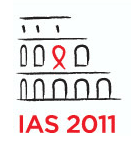 Encouraging preliminary results involving a vaccine being developed by Maryland-based VIRxSYS Corporation were presented Monday, July 18, at the 6th IAS Conference on HIV Pathogenesis, Treatment and Prevention in Rome. Two of five monkeys given the vaccine and then exposed to a primate version of HIV show early signs of being functionally cured, based on blood measurements of viral load, along with measurements of simian immunodeficiency virus (SIV) in blood and tissue cells.
Encouraging preliminary results involving a vaccine being developed by Maryland-based VIRxSYS Corporation were presented Monday, July 18, at the 6th IAS Conference on HIV Pathogenesis, Treatment and Prevention in Rome. Two of five monkeys given the vaccine and then exposed to a primate version of HIV show early signs of being functionally cured, based on blood measurements of viral load, along with measurements of simian immunodeficiency virus (SIV) in blood and tissue cells.
While preventive vaccines are generally designed to prevent infections from establishing in the body, another approach is to develop a vaccine that helps the immune system control, but not eradicate, a virus—a functional cure, should infection be established. Vaccines of this nature are also be explored for treatment purposes, notably to achieve functional cures in those already infected with HIV.
VIRxSYS is exploring the use of lentiviruses—HIV is a lentivirus—to deliver genetic materials to cells that can trigger an immune response. Simply put, the company guts the virus, removing all disease-causing elements, ultimately preserving the viral proteins necessary to spark the immune system.
The study reported at IAS, under the direction of Franck Lemiale, PhD, of VIRxSYS, involved a vaccine dubbed VRX116, a SIV version of the company’s lentiviral vaccine being explored in humans: VRX1273. Five macaques received three injections of the vaccine during an 18-week period, and five received inactive vaccines. One of the monkeys, in the control group, had carried genes consistent with SIV immune system control and survival—in other words, that monkey was an elite controller.
The vaccine was well tolerated in all of the macaques following each of the three injections, with no sign of toxicity, and it generated strong immune responses against the SIV antigens encoded by the vaccine.
Six months after receiving their last injections, the monkeys were exposed rectally to a single, high concentration dose of SIV and then followed closely for 18 months.
Four of the unvaccinated animals died during the 18-month follow-up period, within 17 to 65 weeks following exposure to the virus. The one surviving monkey in the control group was the elite controller.
Three of the vaccinated animals died, with the first macaque dying at 65 weeks post-vaccination and the third animal dying 77 weeks post-vaccination.
Peak viremia—an initial high-level burst of virus after infection—occurred in all the animals. During the “steady state,” when the virus level decreases and generally maintains itself following peak viremia, SIV remained detectable in the five unvaccinated macaques and three of the vaccinated monkeys that died. The two remaining vaccinated macaques had viral loads that went undetectable. While both monkeys have experienced viral load blips—transient detectable levels—they ended the 18-month follow-up period with undetectable levels of SIV.
The two macaques with undetectable viral loads also had undetectable levels of cell-associated SIV DNA—virus inside cells collected from the blood. In contrast, detectable virus was found in blood cells taken from the macaque elite controller and the macaques that died in the study.
The researchers also measured SIV in the guts of the monkeys, which harbors mucosal tissues rich in immune system cells—and virus in infected humans and primates. One of the two macaques described above had undetectable SIV DNA in intestinal tissue, and another had low-level virus. Levels of SIV DNA were significantly higher in the macaque elite controller and both the vaccinated and unvaccinated animals that died.
As for levels of virus in lymph nodes, detectable SIV DNA was documented in all animals, though the two macaques with undetectable viral loads had significantly lower levels of SIV in their lymph nodes compared with the elite controller and deceased monkeys.
The researchers also evaluated CD4 counts. In the four deceased unvaccinated monkeys, CD4s remained below their pre-infected levels for much of the follow-up. Even among the elite controller macaque, there was a downward trend in the CD4 count over time, ultimately falling below the pre-infected level.
Below-infection CD4 counts were also seen in the three vaccinated monkeys that died during follow-up. One of the two surviving vaccinated macaques has maintained a CD4 count above pre-infection levels, whereas the second has more or less maintained its pre-infected CD4 count.
Why three of the vaccinated macaques experienced obvious disease progression—and whether there were any key virologic or immunologic differences compared with the unvaccinated monkeys—wasn’t clear from the data presented by Lemiale’s group.
“Our findings define the achievement of functional cure in a subset of vaccines and warrant clinical investigation, as recently advised by the FDA,” Lemiale and his colleagues concluded. “We are currently finalizing studies, and [VRX1273] is being moved into Phase I clinical trial in a therapeutic setting in HIV-infected subjects. Safety and immunogenicity will be established in this first-in-class, first-in-humans trial.”






Comments
Comments